Boerhaavia diffusa {pa.ran~na.wa}
Update: 2006-08-06 01:57 PM -0700
compiled by U Kyaw Tun, U Pe Than, and staff of TIL. Not for sale.
Family: Nyctaginaceae
1 entry
Boerhaavia diffusa {pa.ran~na.wa}
Main Index of DB | Top
Contents of this page
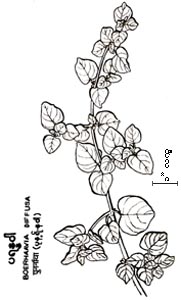
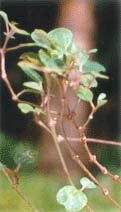
Syn.: Boerhavia adscendens, B. caribaea, B. coccinea,
B. erecta, B. hirsuta, B. paniculata, B. repens, B.viscosa
Burmese-Myanmar transcript names:
Agri.Dept.2000 35-0913:
{pa.ran~na.wa}
FAO :
Lè-seik-shing 271:
{pu.ran~na.wa}
KS-TMN 170: Payan-nawa
Nagathein 2-186:
{pa.ran~na.wa}
UHM 08: Payan-nawa
Myanmar-Script Spelling
Official Myanmar Dictionaries
:
{pa.ran~na.wa} -
-- TravPo-M-Dict 180
{pa.ran~na.wa} - NL - Myan-Engl-Dict
UKT: Both
{pa.ran~na.wa} and
{pa.ran-na.wa} are orthographically the same, except perhaps in the way you pronounce the disyllable {ran~na} which is usually pronounce very fast.
A comparison of the name in Hindi-Devanagari and Burmese-Myanmar is interesting. The word initial in Hindi-Devanagari is पु (Nagathein) which corresponds to{pu.} in Burmese-Myanmar. Since in
{pu.} in some Burmes-Myanmar words (e.g., pu.theim, pu.tat} is pronounced {pa.}, we could easily write
{pa.ran-na.wa} as
{pa.ran-na.wa}. Transliterating Myanmar to Devanagari would then give the word initial as पु.
Hindi:
{pu.nar-na.wa} -- Nagathein
Snathikari; Bengali: Punurnava; Telugu: Punernava -- from: Pankaj Oudhia,
Society for Parthenium Management (SOPAM), 28-A, Geeta Nagar, Raipur - 492001 India,
pankaj.oudhia@usa.net,
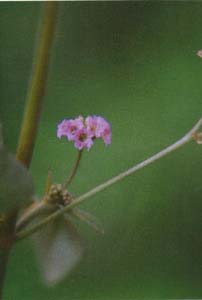
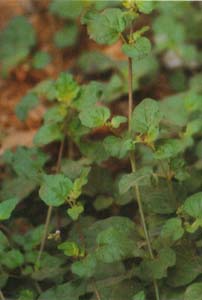 www.celestine-india.com/pankajoudhia; Internet source:
www.hort.purdue.edu/newcrop/CropFactSheets/punanrnava.html
www.celestine-india.com/pankajoudhia; Internet source:
www.hort.purdue.edu/newcrop/CropFactSheets/punanrnava.html
Sanskrit: Punarnava, Raktakanda, Shothaghni, Varshabhu
English common name used in Myanmar :
Agri.Dept.2000 35-0913: Hog weeds
FAO :
Lè-seik-shing 271: Hog weeds
KS-TMN 170: Hogweed, Pigweed
Nagathein 2-186: NG
UHM 08: Spreading Hog-weed
Picture:
Leaders: drawing from Nagathein; photo from
www.allayurveda.com/herb_month_december2003.htm.
Photos: left -- habit; right -- flowers and fruits.
Click on the pictures to enlarge. --KS-TMN
whole plant --
www.garrysun.com/punarnava.html
flower of B. repens --
www.allayurveda.com/herb_month_december2003.htm
Plant identification characters
Perennial herbs, stems terete, tumid at the nodes, decumbent or procumbent, diffusely branched, branches spreading, glabrescent. Leaves opposite, the opposite pair unequal at each node, simple; exstipulate; petiolate; laminae broadly ovate or suborbicular, the bases rounded or subcordate, the margins entire, obscurely undulate, the tips acute or obtuse, unicostate, reticulate, the upper surfaces puberulent, the lower glabrous, silvery white. Inflorescences in axillary umbelloid cymes, the cymules fasicled at the terminal ends, the cymule 1- to 3-flowered; peduncles pubescent; bracts ovate-lanceolate, scarious, deciduous. Flower bracteolate, the bracteoles ovate-lanceolate, pedicellate, bisexual, actinomorphic, hypogynous. Perianth uniseriate, composed of a petaloid calyx, synsepalous, 5-lobed, constricted pink, the tubes below the constriction ovoid, 5-ribbed, densely covered withe many globose viscide glandular hairs, fewer on the ridges, persistent. Androecium polyandrous, stamens 2-3, slightly exserted, the filaments basally connate forming a staminal cup, purplish, the anthers dithecous, globose, dorsifixed, dehiscence longitudinal. Pistil 1, ovary globose, 1-carpelled, 1-loculed, the ovule solitary and basal, the style inserted, purple, the stigma capitate, purple. Fruit an achene, obscurely obovoid, glabrous, the persistent calyx 5-ribbed, globose viscid glandular hairs dense in furrows; seed obscurely obovoid, glabrous, endospermic. Flowering period: October-December. Fruiting period: December-April -- KS-TMN
Nagathein, free translation by UKT.
Based on the flower colour (white, red, and brown, {pa.ran~ran-wa}
is divided into 3 kinds. In Hindi these are: {hsa.hpéd} - white, {laal} - red,
and {nil} - brown. According to {ni.GaN~Ðu. kyam:}, there is still another kind
-- the black, which is very rare. Though all 3 kinds are beneficial to humans,
the brown is more suitable for longevity medication. The plant is not rare and
can even be found commonly in Yangon (Rangoon).
The white kind (white flowers) has leaves tinged red at the edges.
The leaves are thicker, larger, and more succulent than those of the red (red
flowers). The white is more abundant in cool seasons (rainy and winter seasons).
The red can be found all year round. The brown is similar to red. [UKT: The
"brown" seems to be "reddish-brown".]
A common weed in both fallow and cultivated land plant: A diffuse, herbaceous plant, root fusiform, root stalk woody, stem prestate or ascending reaching 0.6-0.9 m. long, divaricately branched, slender, cylindric, thickened at nodes, minutely pubescent or nearly glabrous often purplish -- UHM
Plant: a perennial herb from a fusiform root. Stem: prostrate, decumbent or ascending, 4-10 dm long, rather slender, divaricately branched. Leaves: opposite or sub-opposite, two of a node unequal, broadly ovate or suborbicular, obtuse to rounded or subcordate at the base. Flowers: in pendunculate, glomerulate clusters arranged in slender, long stalkcked, axillary or terminal corymbs. Obovoid or sub-ellipsoid, rounded above, slightly cuneate, below, broadly and bluntly 5-ribbed, very glandular throughout. Flowering and fruiting: throughout the year in Indian conditions -- www.hort.purdue.edu/newcrop/CropFactSheets/punanrnava.html
A creeping and spreading
perennial herb, with a stout root-stock and many erect or spreading branches. It
grows up to 2 metres in length. The leaves of the plant are simple, broad,
somewhat rough, thick and brittle. The flowers are pink or red in color. The
fruits are oval in shape, dull green or brownish in color and about the size of caraway bean.
Ancient ayurvedic texts describe Punarnava as of two types, white and red. Both
of them have identical medicinal value.
Punarnava is slightly bitter in taste and is considered hot, light and dry
in effect. It balances all doshas (vata, pitta and kapha) in the body. Besides
potassium nitrate, it contains an alkaloid, which is known as punarnavine.
Experimental studies have confirmed the diuretic properties of Punarnava. It is
anti-inflammatory, mildly laxative and also a heart tonic. Punarnava is also
known to possess properties to cure skin and soft tissue infections. It is also
used in anaemia cases, loss of appetite, jaundice, obesity and chronic but
non-specific febrile conditions. --
www.allayurveda.com/herb_month_december2003.htm
Distribution in Myanmar:
Grows wild throughout Myanmar, especially at the sandy beaches of streams.
Pegu, Magwe, Minbu, Meiktila, Kado-Kawhnat, Yawnghwe range (Southern Shan State). -- UHM
Part used and uses:
Whole plant -- Diarrhoea; Heart disease; Carminative; Expectorant; Haemorrhoid; Cough; Inflammations; Oedema; Antidote for poisons; Gynaecological disease. Root powder -- Asthma; Unproductive cough; To allay thirst; Ascites; Intermittent fever; Gynaecological disease; Ringworm; Antidote for scorpion venom. Leaf -- Dysuria. -- KS-TMN
Fresh or dried leaves. Used as possess very good diuretic properties and is used in cases of oedema and ascites i.e. those due to early cirrhosis and chronic peritonitis -- UHM
Medicinal Uses: According to Ayurveda, Punarnava is bitter, cooling, astringent to bowels, useful in biliousness, blood impurities, leucorrhoea, anaemia, inflammations, heart diseases, asthma, alternatives etc. The leaves are useful in dyspepsia, tumours, spleen enlargement, abdominal pains. According to Unani system of medicine, the leaves are appetizer, alexiteric, useful in opthalmia, in joint pains. Seeds are tonic expectorant, carminative, useful in lumbago, scabies. The seeds are considered as promising blood purifier. -- www.hort.purdue.edu/newcrop/CropFactSheets/punanrnava.html
Anti-inflammatory activity of various extracts of roots were studied in carrageenin
induced oedema and formaldehyde- induced arthritis in albino rats. Acetone extract
showed most potent anti inflammatory effect. Aqueous extract and alkaloid fractions
significantly inhibited the increased serum aminotransferase activity in arthritic
animals similar to hydrocortisone. Liver ATP (adenosine triphosphate),
phosphohydrolase activity in arthritic animals was also increased by aqueous extract
and the alkaloid. Comparative study for the anti-inflammatory effect of the various
parts of the plant in carrageenin induced hindpaw oedema showed that the activity
was significantly more in alcoholic extracts of roots and leaves as compared to stem
and whole plant. Hypoxanthine-9-L-arabinofuranoside, the nucleoside isolated from
the roots showed that like inosine and adenosine, it relaxes the isolated coronary
artery of the goat contracted with potassium chloride. The action, similar to
that of inosine, is thought to be a direct vasodilator effect, not involving
vascular adenosine receptors. The diuretic action of the plant has been shown
by various investigators, this effect being significantly higher in water insoluble
alcoholic extract of roots and leaves as compared to that of stems and the whole plant.
Fresh juice of leaves is used in dropsy and chronic renal failure in
a dose of 20 ml two to three times a day. Roots boiled with milk are used in a single daily
dose for maintaining health. Topical use of roots has good anti-inflammatory effect.
In a study of 15 patients with nephrotic syndrome treated with the decoction of the crude drug,
six responded well, seven improved, while one patient deteriorated. The plant is well
tolerated, though in occasional patients mild laxation is observed.
--
www.garrysun.com/punarnava.html
Ethnobotany (Worldwide use)
Healing power and curative properties:
Obesity: The herb has been used in indigenous medicine from time immemorial.
Punarnava is highly beneficial in the treatment of obesity as almost all anti-obesity
herbal preparations contain it in one or the other form. It is beneficial in the treatment of
several common ailments. Dropsy (Edema): Punarnava increases the secretion
and discharge of urine. It is effective in the treatment of dropsy, a disease marked
by an excessive collection of a watery fluid in the tissues and cavities or natural
hollows of the body. The fresh boiled herb should be given in the treatment of this disease.
A liquid extract of the fresh or dry plant can also be given in doses of 4 to 6 gms.
Ascities: The herb is useful in the treatment of ascities, a disease
characterised by accumulation of fluid inside the peritoneal cavity of the abdomen.
Much more powerful effect on certain types of ascities that is caused due to the cirrhosis
of the liver and chronic peritonitis.
Stomach disorders: The herb is
useful in strengthening the stomach and promoting its action. It is beneficial
in the treatment of several stomach disorders, particularly intestinal colic. A
powder of the root is given in doses of 5 gms thrice a day. It is also useful in
killing or expelling intestinal worms.
Asthma: Punarnava
promotes the removal of catarrhal matter and phlegm from the bronchial tubes. It
is, therefore, beneficial in the treatment of asthma. A powder of the root can
be taken in small doses three times a day.
Fevers: Punarnava is
beneficial in the treatment of fevers. It brings down temperature by inducing
copious perspiration.
Other diseases: The root of the
plant is useful in the treatment of several diseases - particularly of the
kidney and heart as well as gonorrhoea. It is also valuable in oedema, anaemia,
cough, pluerisy, nervous weakness, constipation and paralysis.
Skin diseases: The root of the plant is an effective remedy for several skin diseases.
A paste of the root can be applied beneficially as a dressing for
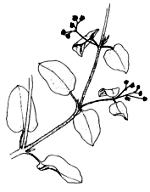 oedematous swellings.
A hot poultice of the root can be applied with gratifying results to ulcers, abscesses and
similar skin diseases.
www.allayurveda.com/herb_month_december2003.htm
oedematous swellings.
A hot poultice of the root can be applied with gratifying results to ulcers, abscesses and
similar skin diseases.
www.allayurveda.com/herb_month_december2003.htm
Drawing from:
www.rain-tree.com/ervatostao.htm
Constituents :
1. Alkaloid - punarnavine C17H22NO2 (15) -- UHM
Root alkaloids (0.05%), triacontanol hentriacontane,ß-sitosterol, ursolic acid, 5,7-dihydroxy-3,4-dimethyoxy-6,8-dimethyl flavone, and an unidentified ketone (m p 86º). The roots contain the rotenoid boeravinones Al, Bl, C2 D, E and F besides the new dihydroisofurenoxanthin, borhavine and an antifibrinolytic agent, punarnavoside. Two lignans, liriodendrin and syringaresinol mono-ß-D-glucoside, have also been reported in the roots1. -- monograph from www.himalayahealthcare.com/products/punarnava.htm
Monograph:
See monograph from
www.himalayahealthcare.com/products/punarnava.htm in TIL library.
Entry format: Botanical name / Family / Ref. Burmese-Myanmar
transcripts ( Agri.Dept.2000 :
FAO :
Lè-seik-shin :
KS-TMN:
Nagathein :
UHM :/ Myanmar-Script Spelling (
Official Myanmar Dictionaries : - TravPo-M-Dict - Myan-Engl-Dict - Myan-Ortho
/ Hindi /
Sanskrit / English common name used in Myanmar / Picture /
Plant identification characters / Distribution in Myanmar / Part
used and uses / Constituents /
End of TIL file